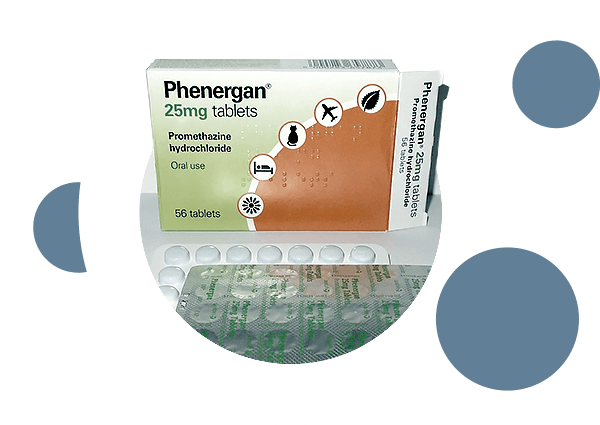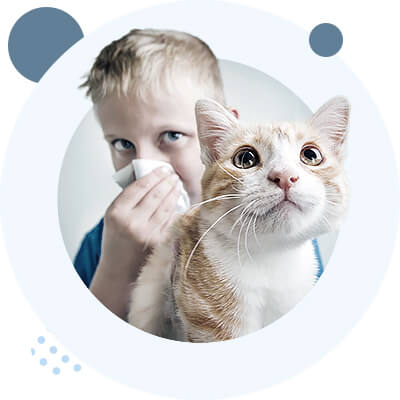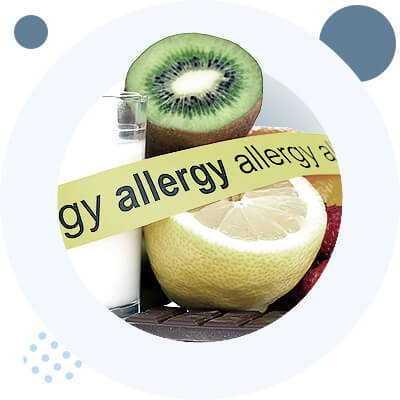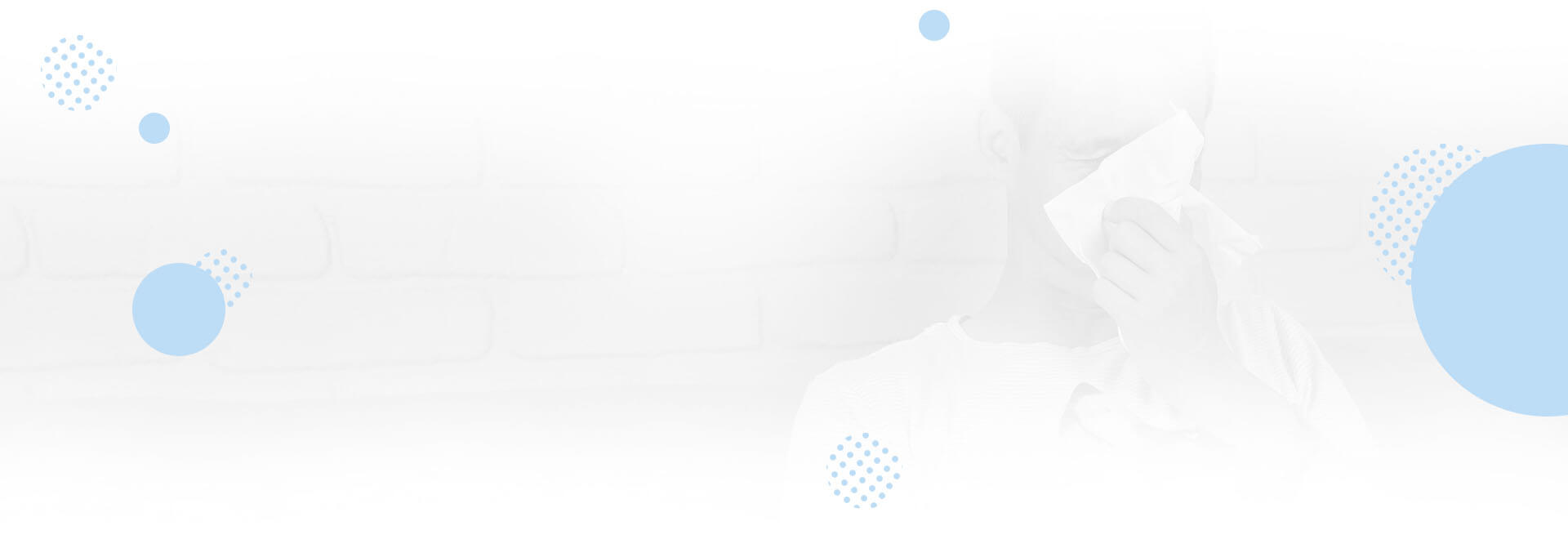Phenergan® is more than a common anti-allergic
Allergies are an increasingly common condition. A major contributing factor to the increasing number of allergies is global pollution. It is no secret that as societies advance industrially, our bodies become less healthy.
It is a proven fact that the growth of pollution in the most populated cities increases the risk of suffering from allergies even for previously healthy people. This increase of harmful particles in the air not only diminishes our health but also increases the protein potential of certain bacteria, viruses, and fungi.
Not only the accumulation of toxic substances in the environment predisposes to allergic processes, but also climate change plays a critical role. The constant emissions of CO2 into the atmosphere favor the appearance of humid conditions and the expansion of pollen, which over time contribute to immunological effects.
The World Health Organization says that more people are suffering from allergies every day and that this is an in growing number if climate change worsens.
Climate change and the radicalization of industries also directly affect food production. According to the FDA, there is a long and growing list of allergenic foods, from sesame to milk, eggs, fish, and crustaceans.
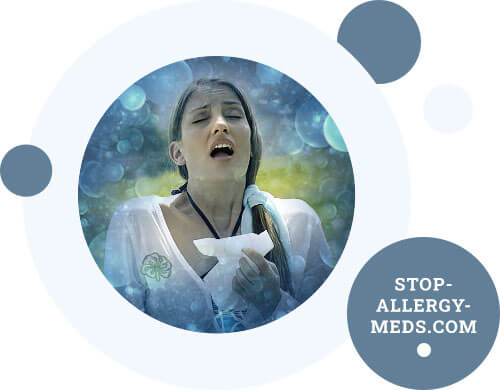
There are more products with the capacity to produce allergies nowadays than before, we must add to this the decrease in our immune system due to the constant exposure to toxic substances suspended in the air. 5% of the population expresses some type of food allergy just in the United States; this is why it is necessary to have antiallergic drugs on hand that can quickly put an end to these annoying symptoms. We never know when an allergic reaction may take place.
The drugs used in allergic reactions are many, but the safest and most effective are antihistamines. These medicines are used in the symptomatic treatment of allergic diseases. They are in charge of inhibiting the action of histamine by taking over their receptors.
ntihistamines are very safe drugs (because they have few or almost no side effects) and very effective in eliminating allergic symptoms. It is used in a wide variety of diseases such as allergic rhinitis or sinusitis.
We can stand out two groups among them: the first generation and the second generation. The first ones have drowsiness as a typical side effect and tend to be used as the first choice. They are highly effective and their use is recommended during the night to have a deep sleep.
The second-generation ones are widely used and are similar to the first generation ones in terms of efficiency and safety, only with small beneficial modifications in their chemical properties.
The first generation includes Dexchlorpheniramine, Hydroxycin, and Promethazine. Promethazine (Phenergan®) is both an antihistamine and an antiemetic, widely used in the medical practice of allergology.
Promethazine is a drug derived chemically from phenothiazine that can be used both orally (taken) and topically (applied as a cream). The story goes that its discovery came about because Rhône-Poulenc scientists were looking for an antihistamine with powerful properties, finding out that Promethazine was not only an outstanding antihistamine but also contributed to the discovery of potent sedatives that are currently used in surgical medicine.
What is Phenergan® and how does it work?
Phenergan® is the commercial presentation of Promethazine Hydrochloride, a medicine that acts by modifying your body's natural responses against foreign substances, such as allergens. Its most predominant pharmacological action is the blocking of histamine H1 receptors. Let's take a peek at the immunological nature of the body.
There are three types of histamine receptors, H1, H2, and H3 in our body. During an allergic response, the H1 receptors are the ones that are most stimulated by the release of Histamine.
Histamine is a substance derived from amines, which is why it is called hist-amine. This substance is largely distributed throughout our body, from the stomach to the lungs and skin.
Histamine is mainly produced by special cells called mast cells. Mast cells are stimulated by other cells of the immune system to release the histamine stored in them during allergy.
This natural substance travels throughout the body once released by the mast cells, reaching the skin, lungs, heart, and blood vessels, causing the typical allergy symptoms: redness of the skin, itching, and runny nose, tightness of the chest, trouble breathing, sneezing and some degree of swelling.
Promethazine is a substance chemically similar to histamine but with no pro-inflammatory potential. It acts immediately during an allergic reaction as a substance that competes with Histamine at the H1 receptors, preventing the Histamine from binding to them and continuing inflammation. When Promethazine binds to an H1 receptor, it does so without activating it, leaving the true activating substance out.
It is interesting how this drug can act fastly once ingested without yielding major side effects other than sleep and relaxation. The ways Promethazine acts in our body are many; also, it has the antiemetic and antitussive capacity thanks to its anticholinergic activity in the central and peripheral nervous system.
Body distribution and elimination:
Promethazine travels through the entire digestive system once ingested with a glass of water. It is absorbed by 25% and widely distributed throughout all tissues. It largely binds to proteins in blood plasma to travel to inflamed tissues.
The onset of effects varies according to how it is administered, from 15 minutes to 1 hour if taken orally or rectally, after 20 minutes if given intramuscularly, and after 3 to 5 minutes if given intravenously. Its antihistamine and sedative effects can remain for 5 to 6 hours.
The metabolism is hepatic through the extensive enzyme system known as Cytochrome P450 CYP, which is invaluable in drug interactions with other compounds.
CYP is an enzymatic system in the liver and other tissues responsible for the drug's metabolism. Its enzymes are classified into "families" according to the similarity between amino acids. As a result of variability, the number of enzymes in the CYP system varies and each drug is metabolized differently.
Its elimination is done after 10 or 14 hours with excretion in the urine and feces of degradation products. Besides, it can also pass through the placenta and be released into breast milk, a consideration we will take into account later.
Indications and contraindications
Promethazine has specific indications as well as any other medication. You have to be very careful when choosing this medication because, like any other, it can have side effects, and we don't want you to suffer them.
Since it has multiple functions in our body, the therapeutic indications are many and they differ a lot from each other. Let us remember that Promethazine works as an antitussive, anti-allergic, antiemetic, and in certain cases, as a sedative.
Indications according to their clinical use:
- It is indicated as a treatment of choice in the symptoms of allergic manifestations such as seasonal or chronic allergic rhinitis, conjunctivitis of allergic origin, angioedema, and hives when they are mild.
- Because of its antiemetic potential, it is indicated in severe and prolonged nausea and vomiting when the cause is known.
- It is also indicated at the same time in the prevention and treatment of kinetic dizziness.
Just as there are indications, there are also contraindications: Promethazine is contraindicated in situations of hypersensitivity to the components of its formulation or to the antihistamine compound itself. It is also contraindicated in allergies to phenothiazines.
Promethazine is contraindicated in any liver disease that causes damage to the hepatocyte resulting in jaundice. It is contraindicated in people with diseases that cause bone marrow depression.
This drug should be avoided at all costs in patients with a seizure disorder. Promethazine is responsible for facilitating -under a complex process- the activation of certain mechanisms that trigger seizure episodes, especially in people diagnosed with a seizure disorder.
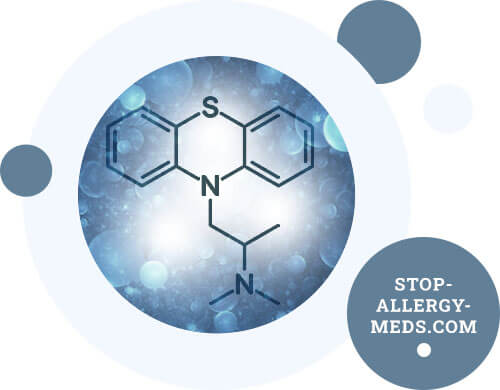
Promethazine should be avoided as much as possible in people with open- or closed-angle glaucoma. Promethazine may have certain ocular side effects due to its potent anticholinergic action. Inhibition of acetylcholine (an essential neurotransmitter in the central nervous system) can cause slight elevations in intraocular pressure that, if left unchecked can trigger an acute glaucoma attack.
In children:
Its use is not allowed in children who are younger than 2 years old. It is not used in children or babies because it can cause respiratory depression (breathing too slow) with a fatal outcome. It must be under strict medical supervision and at the lowest possible dose if used in children and babies. If a child takes Promethazine, its amounts in the body may increase during these processes. If this happens, there is an increased risk of neuromuscular activity, causing involuntary and repetitive muscle contractions that can be very painful.
Promethazine should be avoided in children and adolescents diagnosed with Reye's syndrome.
In pregnancy:
Promethazine is not recommended for use during pregnancy. It has the potential to cross the placental barrier, enter the uterus, and influence the development of the baby. In addition, Promethazine can be released into breast milk, so it should also be restricted during breastfeeding.
Its use can only be recommended when your doctor considers it pertinent and when there are no other options.
In older adults:
Promethazine can be used but with caution. Due to its sedative activity in the central nervous system, it should be used in moderation and at small doses in elderly people with a tendency to faint, hypotension, constipation, and dizziness.
It is no secret that our most loved ones are our grandparents. Grandparents can be slower, can fall asleep, and can get dizzy easily. They can take Promethazine only when necessary and in moderation, always under the guidance of a physician.
Promethazine has significant anti-acetylcholine effects and a worsening of symptoms may be seen in patients with bladder obstruction, gastrointestinal or ileus obstruction, benign prostatic hypertrophy, or urinary retention. The elderly are the most susceptible to the anticholinergic effects of these drugs since there is a natural age-related decrease in acetylcholine activity.
One of the concerns is that it causes drowsiness, so anyone taking this medication should be warned not to drive, cook, or operate machinery while under the influence of this drug. It is recommended that it be used at night or during nap times for this reason.
Interactions with other drugs:
It is well known that every medication has interactions with other drugs. As mentioned earlier, this pill is metabolized in the liver and excreted in the urine and feces, as are many others. Promethazine can interfere with other drugs metabolism since it also has a liver step.
The liver is the crossing point between almost all medications. For example, we take the blood pressure pill in the morning and the thyroid pill at noon; at some point of the day, both pills components are found in the liver as both are metabolized there.
The cytochrome P450 system is the mechanism used by Promethazine in the liver, many drugs use this same enzyme system and this is what determines interactions with Promethazine. We will explain more about this below.
Drug combinations that are NOT recommended:
Ethyl alcohol: Do not consume alcohol simultaneously with Promethazine under any circumstances. Ethyl alcohol can modify the heart and breathing patterns in moderate amounts. This substance by action on vital brain centers produces an increase in heart rate and a decrease in breathing rate. Likewise, Promethazine has a certain effect on the nervous system. A fatal reaction can happen due to the direct compromise of the breathing and the beating if both substances are mixed.
This same mechanism applies to other drugs such as barbiturates, anxiolytics, sedatives, hypnotics, opiate agonists, butorphanol, nalbuphine, pentazocine, tramadol, or other H1-blockers.
Another drug to consider in the interactions is the Sultropide. This is an often-used medication in serious psychiatric disorders that produces disorders in heart rhythm, mainly in ventricular rhythm, if used in union with Promethazine, because the last one potentiates its effects.
The risk of agranulocytosis increases when Promethazine and thyroid pills are used concomitantly, this is an abnormality of the white blood cells that causes them to decrease in the blood count.
Side Effects:
Side effects of almost all drugs are classified according to the frequency in which they appear. We have very frequent, frequent, rare, and very rare effects, according to the Medra classification system.
Side effects generally differ from person to person; do not worry, this does not mean that you will suffer from all of the following symptoms; on the contrary, consult your doctor immediately if you suffer from one of them.
Very frequent side effects are typically related to the dosage occurring in 1 out of 10 people. Only a certain degree of drowsiness is mentioned to date.
Frequent side effects affect 1 in 100 people, and only small changes in consciousness state are known associated with increased sedation to deep sleep.
Remember that the degree of drowsiness will depend greatly on the dose taken and the individual needs of the person. Some people are more sensitive to these drugs; it may be that after a few hours a person feels sleepy, while another person goes on with his life as if nothing happened. It is very personal.
Rare side effects usually occur in about 1 in 1,000 people who take Promethazine. Cardiac changes are described as palpitations, ocular modifications expressed as mydriasis, some central nervous system involvement shown by dizziness, balance problems, decreased memory, and concentration.
Other manifestations have been seen as problems to urinate, hypotension, dryness of the mouth, and other mucous membranes; skin manifestations as rash, itching, and redness, as well as alterations in the mental sphere by hallucinations.
Rare secondary manifestations include blood cell involvement such as leukopenia, neutropenia and thrombocytopenia, swelling of the skin due to fluid accumulation (edema), and insomnia.
Very rare secondary symptoms are few; nervousness, psychomotor agitation, Quincke's edema, agranulocytosis, and increased sensitivity to sunlight.

The side effects of Promethazine are generally associated with the dose consumed so these effects can disappear immediately with minimal adjustment of dose or with the interruption of the drug.
Frequently asked questions:
Can I sunbathe while taking Promethazine?
Yes, you can sunbathe but reasonably. It is advisable to use sunscreen during treatment, as some people are more sensitive to the sun than others, and may suffer from minor burns and spots on the face. The recommended sunscreen to be used while taking medications that produce photosensitization must have a protection factor +30; otherwise you will not be well protected.
What is the route of administration and presentation?
It can be used orally (taken), intramuscularly and endovenous (injected), in a suppository, and topically (in cream).
The doses will always depend on the doctor's instructions and the needs of each patient. Thus, smaller doses are used for the symptoms of dizziness, nausea, and vomiting, while higher doses are used for the symptoms of allergies.
25mg before bedtime or 12.5mg in the day is used traditionally in allergies. In nausea and vomiting, the dose will depend on the patient's weight and age (if it is a child) and the route used. Thus, if administered by mouth, 25mg is used but 6 to 12 mg if it is by injection.
25 to 50 mg is generally required for nighttime sedation if sleep and relaxation are sought in adults. Promethazine can induce calm and a night of continued sleep.
Why choose Promethazine?
Promethazine is an effective drug in the symptomatic treatment of allergies, primarily those in the upper respiratory tract (nose, mouth, pharynx, nasopharynx), allergic conjunctivitis, sinusitis, and rhinitis.
It has also been shown to have a high capacity to stop the skin symptoms of allergies, such as hives. Also, it may be used with epinephrine in more severe reactions, such as anaphylaxis.
It is effective in treating nausea and vomiting when the cause is known. This drug is as effective as Ondansetron against emetic syndrome when used at low doses, according to multiple studies.
Its use in nausea and vomiting is convenient because with lower doses the relief of the symptoms can be gained, compared to those used for Ondansetron.
This medication is not mutagenic or carcinogenic according to the Ames Test. This is an internationalized biological test to evaluate the potential of certain chemical compounds to mutate and produce cancer, so this pill is safe to use.
What to do in case of an overdose?
If you know someone who may be overdosing, call 911 immediately.
Signs that a person is overdosing on Promethazine include decreased heart and breathing rates, breathing problems, fainting, loss of consciousness, and involuntary muscle contractions.
I am taking benzodiazepines, can I take this drug?
No, Promethazine cannot be used at the same time as any benzodiazepine because both drugs can potentiate each other and increase the effects on the central nervous system.
This medicine may be taken near or away from food. Phenergan can also be used during very long trips, in these cases only use it 30 min or 1 hour before traveling.
Remember to consult a doctor before consuming this medicine. You must tell your doctor about the additional medicines you are taking at home during the interview. Always follow your doctor's prescription, and if you miss a dose do not take a double dose to repay for the missed one, on the opposite, take a single dose.
Last but not least, if you feel any discomfort or unusual symptom that you did not feel before taking Promethazine, see your doctor, do not let it go. Your health is important to us.
Allergies are more than just a sneeze
The human body is a masterpiece and has all the essential tools to act in any unfavorable situation. It has been believed for years that our organism is capable of detecting the proper for the strange, and this is more than false.
Allergies are an extremely common condition that affects at least 20% of the world's population, most of which are food-borne. Allergies happen when our body is not able to detect its own and attacks small stimuli or certain substances in an uncontrolled way.
The immune system is the defensive armament that protects us against any threat, whether external or internal; however, many times it can fail and act disproportionately, attacking even our body.
Beyond a simple sneeze or runny nose, allergies represent a complex biochemical process that we should know to detect them and act early. Not every sneeze is an allergy, but every allergy triggers an immune reaction like a sneeze.
What does it mean when you are allergic to something?
It is known as an allergic reaction to that hypersensitivity, exaggerated reaction, developed by any human being as a result of an unknown response to an ''antigen'', which is normally harmless to other people.
An antigen is any foreign substance that generates a rejection reaction in the body. It can be natural or unnatural. An antigen can even be a part of our body.
This unbalanced reaction is carried out by the immune system, which is made up of a variety of cells, chemical substances, and physical interactions that make allergies a more complex process than we could ever imagine.
There are specialized cells in self-recognition and others that play a leading role in the allergies development, called lymphocytes, and are a type of white blood cell that travels freely in the blood. When a lymphocyte comes into action, it activates its different mechanisms to act against one specific antigen.
B lymphocyte
The B lymphocyte is a cell specialized in the immune response given by antibodies. This cell is responsible for producing and releasing protective substances. Antibodies, also known as immunoglobulins, are responsible for recognizing allergens once they have entered our body.
B-lymphocytes are in every corner of our body and therefore, we have specific antibodies in every part of our body with the ability to attack any threat.
| Exp. No. | Treatment | Avg body wt, g | Dose of phenergan, mg/kg | Mortality ratio* | Median survival time,** min. | Avg lung wt,*** g/kg body wt |
|---|---|---|---|---|---|---|
| Rats | ||||||
| I | NH4Cl | 199 | - | 8/15 | 35 | 11.6 |
| II | ' ' + phenergan | 220 | 20 | 4/10 | 20 | 18.2 |
| III | ' ' + ' ' | 206 | 40 | 8/10 | 24 | 14.6 |
| IV | Phenergan | 196 | 40 | 0/10 | - | 6.2 |
| V | No drug | 212 | - | 0/4 | - | 7.7 |
| Guinea pigs | ||||||
| VI | NH4Cl | 461 | - | 8/10 | 8 | 10.4 |
| VII | ' ' + phenergan | 408 | 20 | 12/12 | 8 | 8.6 |
| VIII | Epinephrine | 436 | - | 6/7 | 7 | 19.7 |
| IX | Epinephrine + phenergan | 423 | 20 | 8/8 | 7 | 20.3 |
| X | No drug | 450 | - | 0/5 | - | 6.8 |
| * Mortality ratio = number dead/number used. ** Excluding those surviving indefinitely. *** Avg lung wt in experimental groups include only those animals which succumbed after injection. Control animals were sacrificed under pentobarbital anesthesia. | ||||||
T-lymphocyte
Like the B-lymphocyte, the T-lymphocyte belongs to the white blood cell group but differs from it because its response is cellular, not antibody-dependent.
The T-lymphocyte is in charge of giving a cell-mediated response, of which we can distinguish two types: the CD4 T-lymphocyte and the CD8 T-lymphocyte. The first works by stimulating other groups of cells, it is the one that warns other cells that something is happening.
Within the CD4 T-lymphocytes, we can find small subgroups of cells with specific functions, with Th1 producing gamma interferon and Th2 producing chemicals that act as biological messengers called interleukins.
In contrast to the previous ones, CD8 T-lymphocytes are in charge of neutralizing and destroying infected cells by dangerous microorganisms. How do they perform this function? By introducing chemical substances into infected cells to cause their death automatically, basically, the cell commits suicide, and this process is called cellular apoptosis.
What are allergens and why should we be afraid of them?
Since we know the army that works in our body, it is time to know the enemies, known as allergens.
Allergens are a type of antigen responsible for triggering an allergic response, ranging from dust to dog hair even food.
But not all substances can act as allergens, on the opposite, each immune system has its own properties thanks to the DNA that differentiates every human being, and what may represent an allergen for one person, may not be for another.
The process by which a harmless substance becomes an allergen is not easy to explain and is not completely clear, but according to several scientific studies, it is known that for a substance to become an allergen, certain exposure time is necessary (sensitization) where the chemical properties of the substance interact with our immune system, eventually triggering a hypersensitivity response after some exposure opportunities.
To help you understand it better, we will explain it to you in this way: In people with allergies there is usually a first contact with the potential allergen, in this first contact, there is no indicator that you are allergic and there is no immune response.
During that first moment, the body interacts with that new substance and knows the proteins that make it up. If our organism considers it a real allergen, the production of defenses and antibodies immediately begins.
When a second exposure to the same substance takes place, the allergic reaction arises with an overreaction. This occurs because the immune system has memory and recognizes the same old substance in a second exposure.
There are thousands of allergens, and according to the way they get into the body we classify them into inhalation, ingestion and contact allergens.
Ingestion allergens are the most common type of allergens. In this classification we can find food, food additives, parasites, drugs, and poisons.
Foods are the most common in this group. We can emphasize the milk, the fish, seafood, fruits, vegetables, dry fruits, wheat, gluten, soybean, and peanut, among others. The medicines also are a frequent allergen; they are the penicillins, the cephalosporins, and analgesics, to name a few.
Inhalation allergens give rise to diseases of the respiratory tract, such as allergic rhinitis. These allergens include mites, dust, cat and dog dander, pollen, flour, and mold. The exposure to these particles is usually maintained over time, leading to chronic bronchial diseases such as bronchial asthma or sinusitis.
Types of allergies
It is impressive how a small sneeze can be a huge world full of complex processes with different classifications.
Allergies can be classified into various types of hypersensitivity reactions depending on which component of the immune system response predominates or the nature of the antigen; having type I, II, III, and IV reactions.
Type I hypersensitivity reaction is the immediate response reaction. It is carried out thanks to the prompt support of IgE antibodies. IgE contributes massively to inflammation because it stimulates the formation of substances such as histamine, prostaglandins, leukotrienes, and other natural chemicals. This type of reaction commonly produces typical symptoms depending on the allergen way of entry, which can manifest as rhinitis with a nasal runny nose, tearing, itching, and nose redness to a massive response such as anaphylactic shock.
The type II hypersensitivity response is given by the activation of the cells, also called the cytotoxic antibody response. As explained above, in this type of reaction, T-lymphocytes are activated, which stimulate the activation of other cells, such as neutrophils, to kill other infected cells. This is the traditional mechanism in drug allergies.
Type III hypersensitivity is known to be given by immunocomplexes. Immunocomplexes are formed by the binding of an antigen (foreign substance) to a specific antibody, which is then eliminated from the body.
Finally, the type IV hypersensitivity response is known as the delayed immune response. In this case, they are known as delayed reactions because they occur after several exposures to an antigen, which is the case of the example mentioned above.
The world of immunology is complex and sometimes difficult to explain, however, more and more people have access to information, and thanks to it the allergies are a more understood universe today.
Symptoms:
Symptoms can be grouped according to the way the allergen enters our body, ranging from respiratory, to ocular and dermatological symptoms. The most common are:
Hives: It manifests itself as a rash on the skin, shown as itching, redness and swelling. This type of symptom may disappear completely once the allergen has been eliminated from the body, but for the safety of allergy sufferers, it is preferable to act immediately with antihistamines.
Allergic Rhinitis: Inflammation of the nasal passages affects 15-20% of Americans. It is characterized by watery eyes, runny nose, nasal congestion, frequent sneezing and redness of the nose. It can be seasonal (as a result of weather changes) or year-round due to persistent exposure to an environmental allergen.
Bronchial Asthma: This is a chronic, long-lasting disease resulting from constant exposure to certain allergens that cause inflammation of the bronchial tract, resulting in shortness of breath, dry cough, and tightness in the chest. Asthma is a disease that can be moderate or make daily activities difficult depending on the severity of respiratory problems.
Food allergy: This can happen in a variety of ways, from diarrhea with abdominal cramps to skin rashes. If the allergic reaction is too strong, it can lead to anaphylactic shock.
Angioedema: This is a skin reaction similar to hives, but differs from the last one because it produces strong swelling of the skin, mucosa, and underlying tissues. The causes can be different and can be presented by the consumption of certain foods or medicines.
Anaphylaxis: This is the most severe clinical representation of allergies. It is a case of generalized hypersensitivity that can lead to death. There is the involvement of the respiratory system as well as the heart and large blood vessels in anaphylaxis.
During an anaphylactic reaction, the person may appear desperate with a choking sensation, headache, increased heart rate, and increased breathing. As the reaction progresses, the symptoms become more severe.
The respiratory manifestations are those that endanger the life of anyone, there may be a total closure of the upper airway recognized by the sudden onset of unexplained hoarseness and shortness of breath.
An anaphylactic reaction is an imminent threat of death, so it is necessary to act in time before the symptoms become worse.
Treatment:
There is no magic cure for allergies, and if there were, it would be based on modifying the cause of everything: the immune system. To date, no miracle drugs for allergies are proposed, but drugs that help relieve the symptoms on a large scale such as steroids or antihistamines.
Steroids are medications that specialize in mediating inflammatory responses, allergies included. These drugs are made up of substances similar to those that make up our body and are responsible for inhibiting interleukins, activating lymphocytes, and releasing antibodies and histamine.
The small disadvantage of steroids lies in their side effects. When steroid treatment is prolonged, it can cause many side effects that can be harmful to your health in the long run.
Side effects include acne, skin atrophy, hair loss, weight gain, and susceptibility to kidney damage, increased risk for heart disease, liver damage, and hormonal imbalances that can be a problem for young people during their teen years.
In contrast to the above, antihistamines are drugs commonly used in the medical practice of allergology. This drug acts by blocking the receptors where histamine binds when an allergic reaction takes place, totally inhibiting the effects of the histamine and avoiding the allergic reaction at all costs.
One of the greatest benefits of antihistamines is that they can stop the course of an allergic reaction within minutes and their side effects are just a few.
Side effects of antihistamines may include drowsiness and some degree of dry mouth; however, it has been scientifically proven that these side effects are associated with the consumption of high dosages, and it may disappear with a significant dosage decrease.
Like in any other disease, the best treatment is to find the underlying cause and stop it. In allergies, the basis of treatment lies in suppressing the cause at all costs, either by avoiding contact with animals, decreasing the consumption of certain foods, or cleaning the environment from allergens such as pollen dust.
Since family support is primary in lifestyle changes, it is important that during treatment, both the patient and his or her parents are aware of the allergic process. The use of medication becomes necessary if the patient cannot suppress or avoid the allergen; otherwise, a disease such as bronchial asthma or anaphylaxis can appear if the immune response is not controlled timely.



